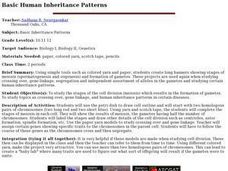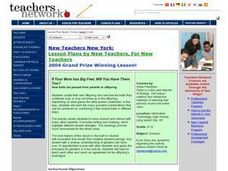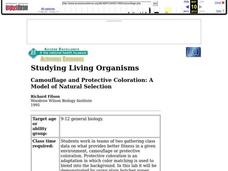Curated OER
When Heredity Follows Different Rules
In this heredity activity, students will create 3 Punnett squares to determine the genotype and phenotype of the offspring from specific breedings. Then students will answer 7 true or false questions based on chromosomes and sex-linked...
Curated OER
Genetics of Parenthood
Students participate in an activity where they flip coins to determine which allele they pass on to the F1 generation and draw the resulting child's face. They identify several inheritance patterns including dominant, recessive,...
Curated OER
Hardy-Weinberg Equilibrium
Students investigate how Hardy-Weinberg Equilibrium is established and what assumptions and conditions are necessary to reach Equilibrium. They model alleles using materials such as index cards, M & M's and goldfish.
Curated OER
Molecular Approaches to Evolution
Students examine the molecular studies of organisms that have led to a new era in their understanding of speciation and evolutionary relationships. Students study the allelic frequency of genes controlling specific molecules and assess...
US National Library of Medicine
Genetic Traits in Harry Potter
Explore human genetics through the world of Harry Potter. A thorough lesson develops the introductory concepts of genetics using characters of the popular book series. Learners study topics from DNA and chromosomes to Punnett Squares and...
Beyond Benign
Kitten Creation
Your pupils become geneticists as they create cat offspring. The next lesson in a series continues an exploration of genetic makeup as scholars consider parent traits to build their offspring. Using household items, they create kittens...
Science 4 Inquiry
Monster Mash-Up of Genetics
It's alive! Young mad scientists create monsters as they explore the probabilities of genetic traits during a well-structured inquiry lesson. Pairs travel from station to station, rolling the dice and adding traits to their creations as...
Serendip
Genetics Review Jeopardy Game
Why not add a little excitement to review day? Play genetic Jeopardy to quiz your classes before they take the assessment. The resource provides a game board in PowerPoint with questions related to meiosis and prediction of traits.
Serendip
Mitosis, Meiosis and Fertilization Vocabulary Review Taboo Game
Can you describe a gamete without using the words sperm or egg? Scholars play a vocabulary review game where they try to get other players to guess their words. Each card has the target word as well as two related words they must not...
Curated OER
Who's the Father?
Students analyze gels to determine parentage in this lesson about scientific evidence, investigation, and DNA concepts. The lesson includes a pre-activity worksheet, a final individual assessment, and student handouts for in-class...
Curated OER
DNA-a Molecular Identity
Students explore about what DNA is and several different DNA typing techniques. They examine three different situations where DNA typing was used to carry out justice. Students also identify and evaluate different uses of DNA typing...
Curated OER
Here's Looking at You
Students assess some common inherited traits which are easily observable and note their phenotype for the trait. Students compare their phenotypes to those of their parents and attempt to describe the pattern and manor of inheritance.
Curated OER
Oompah Loompa Genetics
In this genetics instructional activity, students use descriptive information about the different types of Oompa Loompas to show genotype and phenotype plus dominant and recessive traits. This instructional activity has 12 problems to...
Curated OER
Molecular Approaches to Evolution
Students are introduced to working with molecular data. The first activity does both simulated and original data are used to compare amino acid, protein or DNA differences to construct phylogenetic trees or cladograms. These activities...
Curated OER
Toothpick Fish
Learners experiment with genes and environment for a population of "Toothpick Fish."
Curated OER
Basic Human Inheritance Patterns
Students study the stages of the cell division (meiosis) which results in the formation of gametes and study topics as crossing over, gene linkage, and human inheritance patterns in certain diseases.
Curated OER
Pre-Hardy-Weinberg
Students examine the inheritance of ABO blood groups. In this investigative lesson students perform a lab and show how natural selection can alter the gene frequencies in a population.
Serendip
Using Molecular and Evolutionary Biology to Understand HIV/AIDS and Treatment
HIV mutates rapidly, making treatments challenging to find. Scholars learn about why it mutates so quickly and how scientists race to find treatments. The resource approaches the issue from both a molecular and evolutionary perspective...
Curated OER
Genetics Crossword
In this biology worksheet, students complete a crossword puzzle with 38 questions on genetics. They identify the different parts and functions of a flower.
Curated OER
Why Do We Need Vitamin C in Our Diet?
Students compare/contrast the DNA sequence data of the rat GULO gene to the inactive human GULO gene. They translate and align the sequences, and propose a scenario to explain the occurrence of an inactive DNA sequence to that of an...
Curated OER
If Your Mom Has Big Feet, Will You Have Them Too?
Learners describe and apply the Mendellian principles of genetics, focusing predominantly on dominant and recessive genes. They demonstrate how two parents contribute genes and how those genes appear in their offspring. They describe...
Curated OER
Punnett Squares/Genetics
Ninth graders complete a monohybrid cross and a dihybrid cross. In this biology lesson, 9th graders predict the traits of offspring using the Punnett square. They differentiate recessive and dominant genes.
Curated OER
Natural Selection
Students practice calculating allele and genotype frequencies in the framework of a simple simulation using hard candy, calculators, and a worksheet. This lesson includes a three-page worksheet and an assessment question for conclusion.
Curated OER
Camouflage and Protective Coloration: A Model of Natural Selection
Students collect data and compare whether protective coloration or camouflage provides better biological fitness in a given environment. They simulate predator prey interactions of two different species and use gene frequencies to...

























